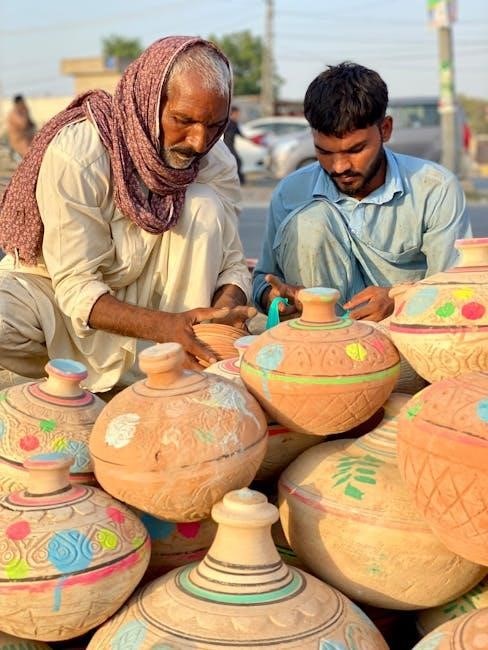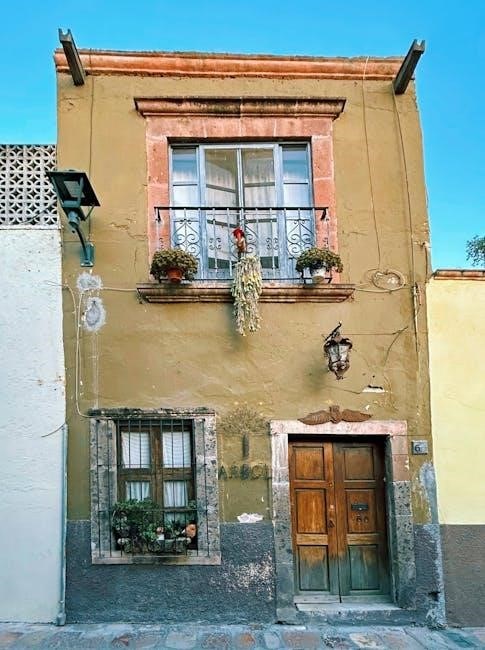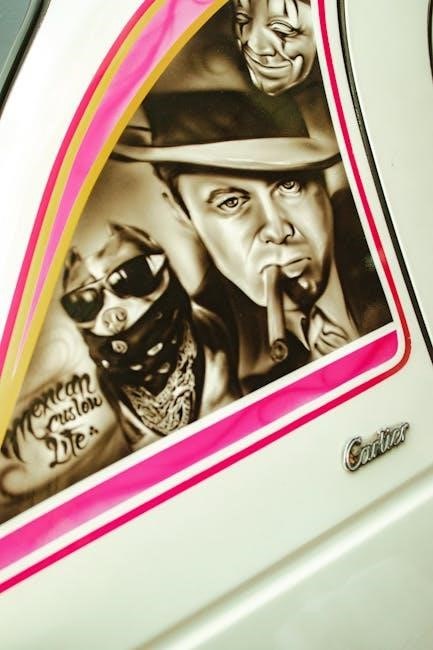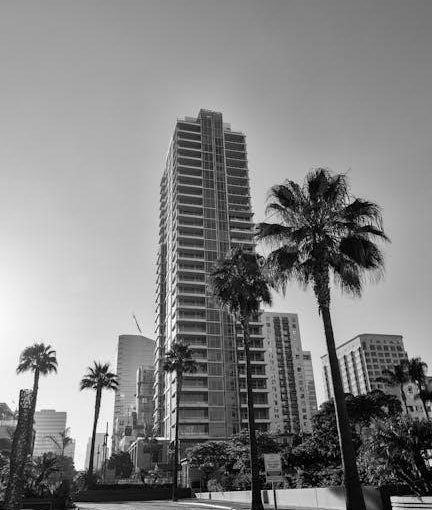The San Diego Street Design Manual is a comprehensive guide outlining principles for safe, sustainable, and equitable streets, ensuring accessibility for pedestrians, cyclists, and transit users while promoting environmental considerations and integration with public transportation.

Historical Context and Evolution of Street Design in San Diego
The evolution of street design in San Diego reflects the city’s growth and shifting priorities. In the early 20th century, streets were primarily designed for automotive traffic, prioritizing efficiency and connectivity. By the mid-20th century, urban expansion led to the development of suburban areas, with streets focused on accommodating increasing car ownership. However, in recent decades, San Diego has embraced a more holistic approach, recognizing the need for multimodal transportation and pedestrian-friendly infrastructure. The city’s street design has evolved to address sustainability, equity, and safety, influenced by changing urban planning philosophies and community feedback. Today, the San Diego Street Design Manual serves as a guiding document, integrating modern principles to create streets that serve all users, from cyclists and pedestrians to public transit riders, while adapting to the region’s unique environmental and cultural context.

Core Principles of the San Diego Street Design Manual
The manual emphasizes safety, sustainability, equity, and integration with public transportation, ensuring streets are accessible, environmentally friendly, and inclusive for all users.
Safety for All Users
Safety is the top priority in the San Diego Street Design Manual, ensuring streets are accessible and secure for pedestrians, cyclists, and vehicles. The manual emphasizes clear visibility, proper signage, and traffic calming measures to reduce accidents. Pedestrian crossings are maximized, and bike lanes are designed to minimize conflicts. Accessibility features, such as audible signals and ramps, are integrated to accommodate all users, including those with disabilities. The manual also addresses vehicle speed management through geometric design elements like narrower lanes and roundabouts. Regular maintenance and inspections are recommended to uphold safety standards. By prioritizing safety, the manual aims to create streets that protect all users and foster a culture of shared responsibility. These guidelines ensure San Diego’s streets are not only functional but also safe and inclusive for everyone.
Sustainability and Environmental Considerations
The San Diego Street Design Manual prioritizes sustainability through green infrastructure and environmentally conscious practices. It promotes the use of permeable pavements to manage stormwater runoff and reduce urban flooding. Bioswales and rain gardens are encouraged to filter pollutants and enhance biodiversity. Energy-efficient street lighting, such as LED systems, is recommended to minimize energy consumption. The manual also advocates for the integration of solar-powered infrastructure and renewable energy sources. Additionally, it emphasizes the importance of tree planting and vegetation in street design to mitigate the urban heat island effect and improve air quality. By incorporating these sustainable practices, the manual supports San Diego’s commitment to environmental stewardship while creating resilient and eco-friendly streets for future generations. These strategies ensure that street design aligns with broader city goals for sustainability and climate action.
Equity and Inclusivity in Street Design
The San Diego Street Design Manual emphasizes equity and inclusivity by ensuring streets are accessible to all users, regardless of age, ability, or socioeconomic status. It prioritizes equitable access to transportation, public spaces, and community resources. The manual promotes inclusive design elements such as accessible pedestrian crossings, audio signals for visually impaired individuals, and seating areas for those who need rest. Additionally, it addresses the needs of underserved communities by encouraging affordable and reliable transit options. By integrating feedback from diverse stakeholders, the manual ensures that street design reflects the needs of all residents, fostering a more connected and inclusive city. These principles aim to create streets that are not only functional but also equitable, ensuring everyone can navigate and enjoy public spaces safely and comfortably.
Integration with Public Transportation
The San Diego Street Design Manual prioritizes the integration of public transportation into street design to enhance mobility and connectivity. It emphasizes the importance of coordinating street layouts with transit systems, ensuring efficient access to bus stops, light rail stations, and other transit hubs. The manual recommends designing streets with dedicated transit lanes and optimized traffic signal timing to improve the reliability and speed of public transportation. Additionally, it highlights the need for pedestrian-friendly and cyclist-accessible transit stops to encourage multimodal travel. By aligning street design with public transportation goals, the manual aims to reduce traffic congestion, decrease reliance on personal vehicles, and create a more seamless and sustainable transportation network for all users. This approach supports the city’s broader objectives of promoting equitable and efficient mobility options.

Key Components of the San Diego Street Design Manual
The manual outlines essential elements, including pedestrian infrastructure, bicycle lanes, vehicle traffic management, and public spaces, ensuring streets are functional, accessible, and aesthetically pleasing for all users;
Pedestrian-Friendly Infrastructure
Pedestrian-friendly infrastructure is a cornerstone of the San Diego Street Design Manual, emphasizing safety and accessibility for walkers. The manual advocates for wide, well-maintained sidewalks, ample crosswalks, and clear signage to guide pedestrians. It also promotes the use of traffic calming measures, such as speed bumps and median islands, to reduce vehicle speeds and enhance crossing safety. Additionally, the manual highlights the importance of curb ramps, accessible pedestrian signals, and wayfinding systems to ensure inclusivity for all users, including those with disabilities. By prioritizing these elements, the manual aims to create vibrant, people-oriented streets that foster community interaction and support a walkable urban environment. These design principles align with broader goals of sustainability and livability, making San Diego’s streets more inviting for residents and visitors alike.
Bicycle Lanes and Cycle Infrastructure
Bicycle lanes and cycle infrastructure are critical components of the San Diego Street Design Manual, prioritizing cyclist safety and accessibility. The manual emphasizes the creation of dedicated bike lanes, separated from vehicular traffic where possible, to reduce collisions and enhance rider comfort. It also advocates for buffered or protected bike lanes in high-traffic areas, along with advanced bike signals and shared-lane markings to guide cyclists. Additionally, the manual recommends the installation of bike racks, repair stations, and showers at key destinations to support cyclists’ needs. These design elements aim to encourage cycling as a viable transportation option, promoting physical activity and reducing traffic congestion. By integrating bike infrastructure with public transit, the manual fosters a seamless and sustainable transportation network for all users. This approach aligns with San Diego’s broader goals of creating a more livable and environmentally conscious city.
Vehicle Traffic Management
Vehicle traffic management is a key focus of the San Diego Street Design Manual, aiming to optimize traffic flow while ensuring safety and efficiency for all road users. The manual outlines strategies to reduce congestion, such as intelligent traffic signal timing, dedicated turning lanes, and clear lane markings. It also emphasizes the importance of managing traffic volume through dynamic lane allocation and ramp metering. These measures are designed to minimize delays and reduce the likelihood of accidents. The manual further integrates traffic management with public transportation and pedestrian infrastructure, ensuring a balanced approach to mobility. By prioritizing efficient traffic movement, the manual supports San Diego’s goal of creating a safe, accessible, and sustainable transportation network for all users. These strategies aim to enhance the overall driving experience while accommodating the city’s growing population and diverse transportation needs.
Public Spaces and Landscaping
Public spaces and landscaping play a pivotal role in enhancing the functionality and aesthetics of San Diego’s streets. The manual emphasizes the importance of creating inviting and accessible public areas that encourage social interaction and community engagement. Landscaping elements such as trees, green spaces, and decorative plantings are integrated to beautify streets while providing shade and improving air quality. The design guidelines advocate for pedestrian-friendly features like seating areas, public art, and accessible pathways. These elements not only enhance the user experience but also contribute to the overall sustainability of urban environments. By incorporating thoughtful landscaping, the manual ensures that public spaces are both functional and visually appealing, fostering a sense of place and community pride. This approach aligns with San Diego’s commitment to creating vibrant, livable streets that benefit all residents and visitors.
Implementation Strategies and Best Practices
The San Diego Street Design Manual outlines strategies for effective implementation, including community engagement and phased construction, ensuring streets are built to last while minimizing disruptions.
Community Engagement and Feedback
Community engagement is a cornerstone of the San Diego Street Design Manual, ensuring that street design reflects the needs and preferences of all users. The manual emphasizes the importance of inclusive public participation through workshops, surveys, and public hearings to gather diverse perspectives. This approach fosters trust and transparency between residents and city planners. Feedback mechanisms are designed to be accessible, with both in-person and digital platforms available for input. By prioritizing community voices, the manual ensures that streets are not only functional but also culturally and socially responsive. Iterative feedback loops allow for continuous refinement of designs, ensuring that final outcomes align with the community’s vision for safe, sustainable, and equitable streets. This collaborative process is vital for creating spaces that serve everyone, from pedestrians and cyclists to drivers and transit riders.
Phased Construction and Maintenance
Phased construction and maintenance strategies are integral to the San Diego Street Design Manual, ensuring that improvements are implemented efficiently without disrupting daily life. The manual advocates for breaking large projects into manageable phases, allowing for sequential upgrades that adapt to evolving needs and budget constraints. This approach also enables the city to address high-priority areas first, such as safety hotspots or transit corridors, while gathering feedback from users before proceeding to subsequent phases. Maintenance plans are integrated into the design process, with specifications for materials and features that minimize long-term upkeep costs. Regular assessments and adaptive management ensure that streets remain functional and safe over time. By balancing immediate needs with long-term goals, phased construction and maintenance support sustainable and resilient urban development in San Diego.
Case Studies and Success Stories
The San Diego Street Design Manual highlights several case studies demonstrating successful implementation of its principles. One notable example is the downtown revitalization project, which transformed a busy thoroughfare into a vibrant public space with improved pedestrian infrastructure and bike lanes. The project not only enhanced safety but also boosted local businesses and community engagement. Another success story is the implementation of “complete streets” in suburban areas, which prioritized multimodal accessibility and sustainability. These projects showcase how the manual’s guidelines have led to tangible improvements in safety, environmental sustainability, and equity. By documenting these successes, the manual provides valuable insights for future street design initiatives, ensuring that San Diego continues to set a benchmark for modern urban planning and community-centered development.

Future Trends in San Diego Street Design
San Diego’s street design is poised to embrace innovative trends that prioritize sustainability, technology, and inclusivity. The updated manual emphasizes integrating smart traffic systems, such as real-time data analytics, to optimize traffic flow and reduce congestion. Green infrastructure, like permeable pavements and urban trees, will play a larger role in managing stormwater and mitigating the urban heat island effect. Additionally, the city is exploring the incorporation of autonomous vehicles into its street design, ensuring infrastructure is adaptable to future transportation needs. Public spaces will also evolve, with a focus on creating vibrant, community-driven areas that encourage social interaction and physical activity. By blending cutting-edge technology with eco-friendly practices, San Diego aims to set a new standard for modern street design, fostering a more connected and sustainable urban environment for generations to come.
The San Diego Street Design Manual is a comprehensive resource that guides the creation of safe, sustainable, and inclusive streets. It prioritizes the needs of all users, ensuring equitable access and environmental stewardship. The manual provides clear guidelines for designers and policymakers, fostering innovation and consistency in street design. Community engagement has been vital in shaping its principles, reflecting the diverse needs of San Diego’s residents. As the city evolves, the manual adapts to emerging trends and technologies, serving as a flexible framework for the future. Its implementation enhances urban infrastructure and contributes to the quality of life, positioning San Diego as a leader in progressive street design. The manual’s success lies in balancing current needs with future aspirations, ensuring a sustainable and connected community for years to come.
